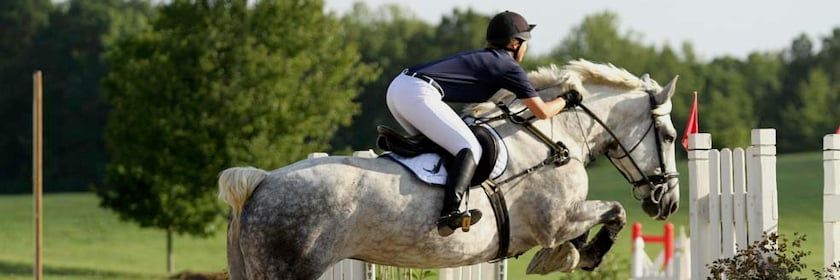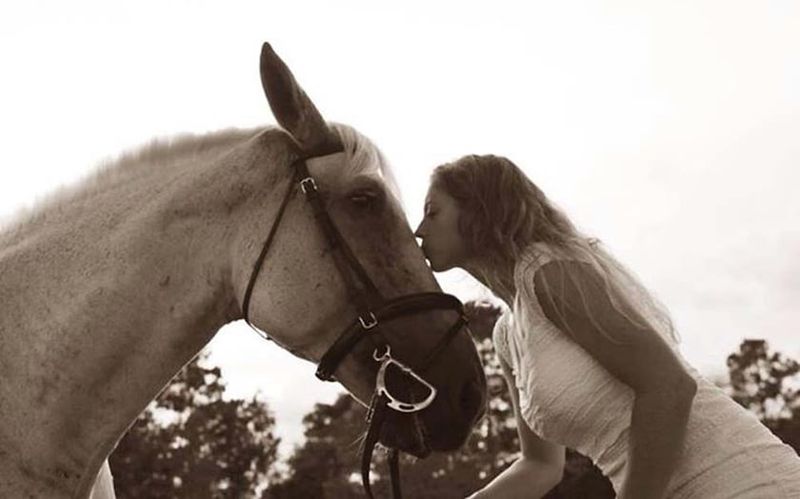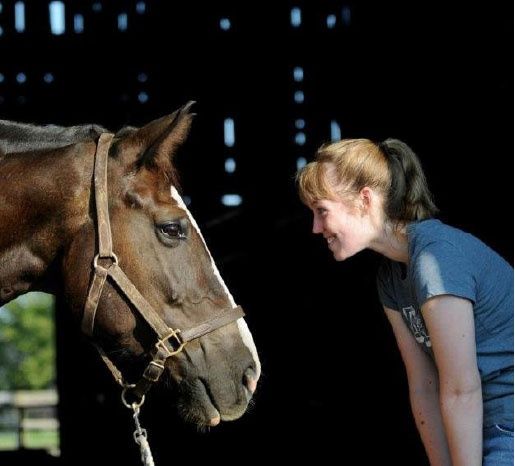The Jumping Percheron


When you think of horses effortlessly sailing over three and a half foot fences, chances are you imagine a pony, a Thoroughbred, or a stock horse. The last thing you probably envision is a full-blooded 1,300-pound Percheron—especially one who makes it look easy.
Sgt. Stacey Chepren does just that with her gray mare Klein. The pair have completed horse trials and combined tests as far as the preliminary level (jumps of 3’7) and have won multiple All Breeds Championships through the U.S. Dressage Federation at first level.
Looking back over more than a decade with Klein as her partner in crime, Chepren admits she didn’t see any of this coming when she first decided to buy a Perch.
Chepren said she had a lifelong fascination with draft horses, dating back to seeing a team of Belgian mares at the barn where she kept her first riding horse in Colorado. She picked up a job at a carriage barn and learned to drive teams of horses. Then, she joined the Air Force and was stationed in Hawaii. She kept up her horse habit by helping a trail riding stable acclimate their new horses to life on the island, but buying a horse of her own wasn’t in the plan.
The Percheron Horse originated in the province of Le Perche, near Normandy in France.
A dumb thing to do
Then she came across an ad for a gray Percheron filly on a Canadian rescue site and something told her the horse was special. Against all reason, Chepren adopted her and began researching horse cargo flights.
“It was a dumb thing to do, buying a horse I’d never seen, and it was even dumber to bring her to Hawaii because I knew I had to get her back [to the mainland] again,” she remembers. “I didn’t know why, I just had to have this horse. And she’s been the best thing that’s ever happened to me.”
Klein was barely halter broke when she arrived. Chepren could tell she was refined for a full-blooded draft, but mostly envisioned riding the mare along the trail or strolling along the beach. Jumping or serious competition weren’t on her radar.
“I took her everywhere with me, like she was a dog on a leash,” she remembered. “I took her to get the mail at the farm, she followed me around. I didn’t get on her for a little while because she had just turned three, and when it was time to get on her she just looked like me like, ‘Ok, so you’re up there now. So what?’”
One fence at a time
Chepren remembers hand-walking Klein over a few ground rails at the barn one night, just to show her something new.
The mare bucked and squealed like this was a fabulous new game.
So, Chepren tried trotting her over some rails under saddle. Klein was fascinated, always looking for the next rail and pulling forward eagerly to the next one. They gradually put the fences up, and to Chepren’s surprise, the mare kept enjoying herself and made the obstacles look like child’s play. Gradually, Chepren began considering whether Klein wanted to be an event horse, so she began training her at the lower levels and moved up gradually.
“The day she tells me she doesn’t want to do it, she doesn’t have to, but so far that day hasn’t come. And she never struggled either,” she said. “It’s not like she was ever tapping rails. She has never had a problem making the time in evening when some light horses weren’t making it.”
Chepren admits there have been critics of her journey with Klein, which she documents on her blog The Jumping Percheron—mostly from people who question whether there could be long-term impacts from jumping a horse so large. Chepren consulted an equine physiologist and reviewed their conditioning program to ensure she doesn’t put too much stress on Klein’s joints. So far, the mare has had no soundness problems, even as she approaches the middle of her teenaged years.
She also recognizes Klein is a unique specimen. She is lighter and more refined than most full-blood draft horses, and her body proportions and joint angles make this type of work much easier for her than it would be for a more classic draft horse whose build would be better suited to pulling a heavy load behind them. Chepren points out that just because Klein has excelled, she doesn’t advocate everyone hop on a full draft and expect them to do the same.
The Percheron was the favorite of both the American farmer and the teamster who moved freight. Widespread mechanization on farms after WWII rendered the Percheron nearly extinct.
The heart of a million horses
Klein provides Chepren a welcome respite from her job as a paralegal in the Air Force JAG division. It can be a time-intensive, stressful position, but horses give her a designated time to collect her thoughts and leave work behind. Sometimes that means skipping a lunch or staying late in order to have more time at the barn, but she doesn’t mind.
“If you really love something, it’s not a matter of finding the time—you make the time,” she said. “You do what you have to do. If that means you have to get up earlier, you get yourself out of bed. You either want it badly enough or you don’t.”

Since their beginnings, Chepren and Klein have left Hawaii for New Jersey, and more recently were transferred to the Las Vegas area. Chepren’s herd now includes a Belgian, a Pony of the Americas, and a Thoroughbred, but Klein will always hold a special place in her heart.
“She’s one of those horses who doesn’t know when to say when, so you have to be careful with that. She has the heart of a million horses,” Chepren said. “I’m convinced Klein would pull me out of a burning building, because she knows I would do the same for her. She’s the best.”
Tags:Horse Sense

Acreage Life is part of the Catalyst Communications Network publication family.
















